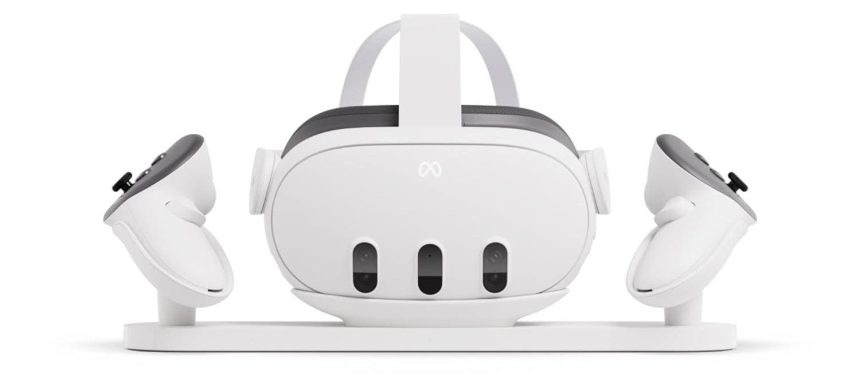The Meta Quest 3, successor to the Quest 2, offers a compelling standalone VR experience, boasting enhanced features and a sleeker design. While setting up the device, a series of comical mishaps ensued involving the optional wireless charging stand. In an attempt to relocate the stand, the headset took a tumble, resulting in a minor scratch. Undeterred, and clearly not learning from the initial incident, a second relocation attempt launched a controller on an unexpected flight down a staircase. Remarkably, despite these unplanned stress tests, the Quest 3 and its controller emerged fully functional, a testament to the hardware’s durability. This anecdote serves as a cautionary tale about the charging stand’s slippery design, highlighting the need to remove the headset and controllers before moving it.
The Meta Quest 3 offers a compelling value proposition in the VR market. Priced at $499.99 for the 512GB model, it includes the popular game Batman: Arkham Shadow and a three-month subscription to Meta+. This positions it competitively against the PlayStation VR2, which requires a PS5 console and retails for $549.99. The Quest 3’s primary advantage lies in its standalone functionality. Untethered by wires or base stations, the Quest 3 provides a truly freeform VR experience, powered by its integrated Snapdragon XR2 Gen 2 chipset. This onboard processing allows for instant immersion, simply by charging the headset and putting it on. The processing power is comparable to a mobile device, unless connected to a PC for enhanced graphical capabilities. While this review didn’t involve testing the PC tethering feature, it remains an area of interest for future exploration.
The Quest 3 showcases several notable improvements over its predecessor. The headset is slimmer and more comfortable, featuring upgraded pancake lenses for enhanced visuals. The front-facing visor cameras have also been upgraded, facilitating improved color passthrough for mixed reality experiences. Meta’s promotional material, featuring the Quest 3 in various lifestyle scenarios, while not entirely convincing, hints at the device’s potential beyond gaming. The redesigned Touch Plus controllers are more streamlined, having shed the bulky tracking rings of the previous generation. Haptic feedback is present, though not as refined as that of the PSVR2 or DualSense controllers. Notably, the Quest 3 lacks in-headset rumble, a feature appreciated on Sony’s device. Hand-tracking functionality is available, but physical controllers remain the preferred input method. The Quest 3 accommodates glasses wearers with adjustable face padding, although dedicated prescription VR lenses offer a more comfortable solution.
The Quest 3’s visual quality is impressive, if not perfect. Dual 2064 × 2208p LCD panels offer a near-4K experience, although the PSVR2’s OLED display provides more vibrant colors and deeper blacks due to its inherent technology and the power of the connected PS5. However, the Quest 3’s superior pancake lenses offer greater clarity and focus compared to the PSVR2’s Fresnel lenses. Testing a variety of VR games, including Batman: Arkham Shadow, Arizona Sunshine Remake, and Meta Horizon, revealed the capabilities of the Quest 3’s enhanced hardware. While traditional VR gaming proved enjoyable, it was the mixed reality experiences that truly captivated.
The Quest 3’s color passthrough functionality elevates mixed reality gaming to a new level. While the passthrough image retains a slightly grainy quality, it doesn’t detract from the immersive experience. Games like Starship Home, which seamlessly integrates the virtual spaceship with the real-world environment, offer a truly innovative gameplay experience. Other mixed reality titles, such as First Encounters and the meditation app Pillow, further demonstrated the potential of this technology. The added benefit of mixed reality is its reduced likelihood of inducing motion sickness, making it accessible to a wider audience. The Quest 3’s integrated audio is adequate, though using the Razer Hammerhead earbuds, specifically designed for Meta devices and providing low-latency audio via a dongle, delivered a superior audio experience. The Elite battery pack strap proved useful for extended gaming sessions, though the headset’s two-hour battery life (four with the strap) was generally sufficient for average playtimes.
Ultimately, the Meta Quest 3’s mixed reality capabilities are its most compelling feature, hinting at the future direction of VR technology. While current VR headsets remain somewhat cumbersome for mainstream adoption, the Quest 3’s advancements in comfort and functionality represent significant progress. As hardware continues to evolve, becoming more streamlined and affordable, the potential of mixed and augmented reality will become increasingly undeniable. The Quest 3 provides a compelling glimpse into this future, offering a compelling and immersive VR/MR experience with enhanced hardware and innovative features. The anecdotal experiences with the charging stand serve as a humorous reminder of the realities of integrating new technology into our lives. Despite these minor hiccups, the Quest 3 proves to be a robust and promising device poised to further popularize the world of virtual and mixed reality.



